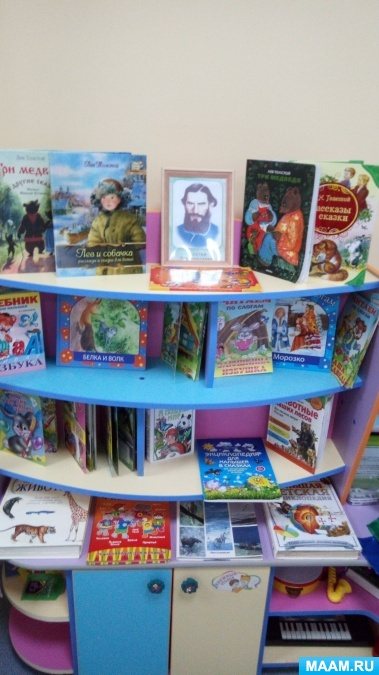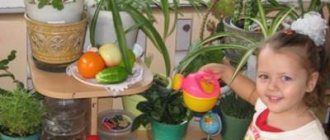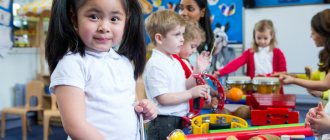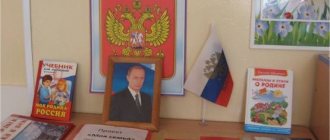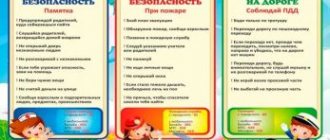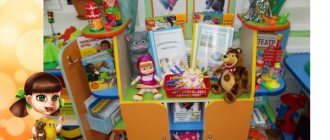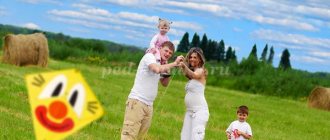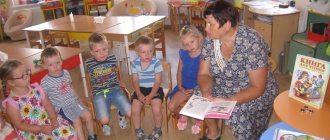Recommendations for equipping a book corner in preschool groups
Guidelines for equipping a book corner
in different age groups
A book corner is a necessary element of a developing subject-spatial environment in a group room of a preschool institution. Its presence is mandatory in all age groups, and its design and content depend on the age of the children. The corner should not be a ceremonial corner, but a working one.
Its purpose is not to be a bright, festive decoration for a group room, but to enable a child to communicate with a book.
The main task of teachers is to instill in children a love of the literary word, respect for the book, and the development of the desire to communicate with it, i.e., everything that forms the foundation for raising a future “talented reader” through the book corner of the group / The book corner is located away from where children play , since noisy games can distract a child from focused communication with a book. You need to think about the right lighting: natural (near the window) and electric (table lamp, wall sconce) for the evening.
In the design of a corner of a book, each teacher can show individual taste and creativity - the main conditions that must be met are convenience and expediency. The book corner should be cozy, attractive, conducive to leisurely, focused communication with the book. It is important that everyone can choose a book according to their own taste and calmly look at it.
The selection of literature and pedagogical work organized in the corner must correspond to the age characteristics and needs of children.
The frequency of book exchange also depends on the specific goals of introducing children to reading. The composition of the book corner may not change for a week or even two when both the teacher and the children constantly need to access it. On average, the shelf life of a book in a book corner is 2-2.5 weeks. However, the basic rule must be observed: the book remains in the corner as long as the children remain interested in it. But, if a change of books has occurred, the children need to point this out or ask them to notice it, give them the opportunity to look at new books, ask the children what stopped their attention, what book they wanted to read right there.
Basic requirements for the design of book corners in groups of senior preschool age:
1. Rational placement in the group.
Choose a suitable location. If possible, the book corner should be located away from the play area, closer to the window. This should be a cozy, quiet and peaceful place in which a preschooler can “communicate” with literature. The main criterion when choosing books is the teacher’s consideration of the children’s literary interests and their age characteristics.
2. Compliance with the age and individual characteristics of the children in the group.
When designing a book corner, you should take into account expediency and convenience. The corner should be attractive, cozy, conducive to focused, leisurely communication with the work. The selection of literature and pedagogical work carried out in the book corner must correspond to the age needs and characteristics of children 3. Compliance with the interests of children.
Arrange the books correctly. The book corner contains publications that are well known to children. It should be remembered that, despite the different tastes of children, they all love fairy tales and humorous rhymes. In addition to the books themselves, there may also be individual colorful educational pictures that are pasted onto thick paper. The works of S. Marshak, N. Nosov, and E. Uspensky remain among the most beloved. Along with fiction, books dedicated to flora and fauna can be placed on the shelves. By looking at pictures, children enter the natural world and learn to better understand the world around them.
4. Constant turnover. The frequency of book exchange also depends on the specific goals of introducing children to reading. The composition of the book corner may not change for a week or even two when both the teacher and the children constantly need to access it. But, if a change of books has occurred, the children need to point this out or ask them to notice it, give them the opportunity to look at new books, ask the children what stopped their attention, what book they wanted to read right there.
5. Aesthetic design.
The book corner must be designed in accordance with the requirements of SaniP
6. Demand.
Each child in the book corner should find a book according to his desire and taste.
Contents of the preparatory group's book corner. The older the children, the more serious and voluminous the books are located in the book corner. The number of books should not be regulated. It depends on the tasks that the teacher sets in working with children during the day or week.
In the preparatory group it is recommended to place in the book corner:
books on various topics (each child should find a book according to his desire and taste: stories about the Motherland, war, adventures, animals, natural life, plants, poetry, humorous works, etc.):
2-3 fairy tales;
poems, stories aimed at developing the civic personality traits of a child, introducing him to the history of our homeland, to its life today;
publications of works that children are currently being introduced to in class;
funny books by S. Marshak, S. Mikhalkov, N. Nosov, V. Dragunovsky, E. Uspensky and many other writers with illustrations by our best artists;
books that children bring from home;
books on school topics are added;
thematic albums for viewing. These can be albums specially created by artists on certain topics (“Different Animals” by N. Charushin, “Our Children” by A. Pakhomov, etc.), albums compiled by the teacher together with the children from individual postcards and drawings about work, nature in different seasons, books of this or that writer, etc. There should also be illustrations by artists for books;
portraits of famous children's writers and poets.
To help children learn and remember letters better, you can place different types of alphabet in the book corner: prose, poetic, artistic.
There should be a library in the book corner of preparatory groups. It is necessary to prepare attributes for the role-playing game “Library” (forms for each child, index cards for each book, etc.)
Children take books from the library according to their desire and taste, but then be sure to put them back in their place. In the preparatory group, you can organize the duty of pupils who issue and receive books and are responsible for their safety.
Children of the seventh year are taught to understand the motives of the heroes’ actions, the position of the author and his attitude towards his heroes. Preschoolers gain deeper knowledge of how a book is created, how many people work to ensure that it reaches the reader.
Conversations with older preschoolers must be combined with showing illustrations, repeated reading, organizing dramatization games, and frequent return to previously read books, because with age, children perceive them differently, more consciously.
Book characters come to life in the drawings and modeling of preschoolers. The best drawings are used to create albums and exhibitions for the book corner.
Children get special pleasure from looking at funny pictures in humorous books. Communication with them not only brings joy to children, but is also useful for them, as it develops the ability necessary for a person to feel and understand humor, the ability to see the funny in life and literature.
In preparatory groups, children can already repair books on their own. Therefore, materials for repairing books should be placed in the book corner.
Also in the book corner, the teacher and the children organize thematic exhibitions.
Their main goal is to deepen the literary interests of children, to make one or another literary or socially important topic particularly significant and relevant for preschoolers. The theme of the exhibition must be important and relevant for children (connected with the upcoming holiday, the anniversary of a writer or illustrator, with the content of the planned matinee).
Rules that are important to follow when organizing a thematic exhibition.
The theme of the exhibition must be important and relevant for children (related to the upcoming holiday, the anniversary of a writer or illustrator, the content of the planned matinee, etc.)
A special, careful selection of books is required in terms of artistic design and external condition.
The exhibition should be short in duration. No matter how important its topic is, no matter how attractive its design, it should not last more than 3-4 days, because... further, the attention and interest of preschoolers will inevitably decrease
Requirements for organizing an exhibition: - thematic exhibitions are planned 1 month before its registration. — 5-6 or more are planned per year. — the theme of the exhibition should be meaningful and relevant for children:
•upcoming holiday; •anniversary of a writer, artist and illustrator; •upcoming matinee. - careful selection of books in terms of decoration and external condition.
— the exhibition should not be long.
Duration approximately 3-4 days, because... further interest will decrease.
Pedagogical work with children during exhibitions:
Conversations with children, activities; Selection of various materials:
•books, •artist illustrations, postcards, •badges, •small sculptures, photographs, •children's drawings •and other exhibits. The children are attracted to the arrangement of materials, and their skills are focused on aesthetics. Inviting guests (children from a neighboring group, parents). Formation of dialogical communication: the ability to ask questions, answer questions asked. Formation of a culture of behavior (etiquette). Visiting exhibitions in other groups.
Age group
Corner equipment
Educational work with children
1 younger
There should be a few books in the book corner - 4-5, but the teacher should have additional copies of the same books in stock:
Books on a dense basis based on familiar fairy tales, nursery rhymes, no more than 5 sheets in volume;
Books with dynamic elements (moving eyes, opening and closing windows, etc.);
Books of different formats: half-books (half a landscape page), quarter-length books, little books;
Panorama books (with folding decorations and moving figures);
Musical books (with animal voices, songs of fairy-tale characters, etc.);
Folding books, including those made by yourself;
Subject pictures depicting objects of the immediate environment (pieces of furniture, clothing, dishes, animals), subject pictures with the simplest plots.
The teacher gives children the first lessons in independent communication with books: teaches them to look at books and pictures only there, tells the rules that must be followed (take books with clean hands, leaf through carefully, do not tear, do not crush, do not use for games; after looking, always put the book back, etc.).
2 junior, middle
There should be 4–5 book titles in the corner.
Books with hard sheets, as in 1st junior;
books with a regular sheet structure;
prints on themes of Russian folk tales.
Plot pictures based on fairy tales and program works.
The teacher consolidates knowledge about the structure and purpose of a book corner, teaches children to independently and carefully examine books. In the second junior group, work continues, taking into account the increasing complexity of the tasks set by the preschool educational program. We place familiar literary works in the book corner, and each child can come up, watch their favorite fairy tale, and talk about it with their peer
Average
In the book corner it is necessary to place familiar fairy tales, stories about nature, animals, etc. (4-6 books, the rest are in the closet).
Books with the same work, but illustrated by different artists;
The albums are supplemented by themes: “Russian Army”, “Adult Labor”, “Flowers”, “Seasons”;
Postcards for viewing by work;
Portraits of writers: S. Marshak, V. Mayakovsky, A. Pushkin;
Thematic exhibitions “Fairy Tales”, “Seasons”, “Tales of Animal Friendship”, etc. are organized (once a quarter);
Book repair material
In the middle group, preschoolers already show great interest in books. They look at the illustrations for a long time, exchange opinions on the content of the fairy tale or story. You can offer for consideration, for example, the same fairy tale “Turnip”, but illustrated by different artists (Yu. Vasnetsov and V. Dekhterev). This encourages children to express their impressions of the book, how the characters are depicted, and which illustrations they liked best. Picture books are used less often; new fairy tales, poetic works, books about nature, and funny books are added. Children dramatize familiar poems and fairy tales and show their attitude towards the characters. Children develop stable skills in handling books carefully. Five-year-old children can be involved in simple gluing of bindings, in making an album with pictures, and in making character crafts for a shadow theater.
Older
Content: 10-12 books of various subjects and genres (there may be books of the same title, but illustrated by different artists);
Portraits of writers: M. Gorky, S. Mikhalkov, B. Zhitkov, L. Tolstoy, N. Nosov, K. Chukovsky;
books recommended by the program;
Books are homemade books consisting of children's stories written down by adults, illustrated by the children themselves;
Encyclopedias (“smart” books), dictionaries;
"Thick" books;
Albums or illustrations are supplemented with information about the Motherland, technology, and space;
sets of postcards related in content to the themes of fairy tales, literary works, cartoons;
Portraits of artists - illustrators (E. Rachev, N. Charushin);
Periodically (once a quarter) thematic exhibitions “Funny books”, “Books about our country”, etc., exhibitions with children’s drawings on a given topic are organized.
Pedagogical guidance is becoming more correct, because Children are already quite independent in choosing books.
The teacher teaches independent, focused communication with a book. Looking at a recently read book gives the child the opportunity to relive what he read and deepen his initial experiences.
The teacher pays attention to “smart” books and turns to them for answers to children’s questions; introduces dictionaries.
“Thick” books are read for a long time (with continuation).
Book repair workshops are also organized in senior groups. Children themselves select the necessary materials - paper by color and thickness, glue, etc. While working together, they remember the contents of the books and share their impressions of the actions of the heroes.
Preparatory school
The number of books in a corner is not regulated.
books on various topics (each child should find a book according to his desire and taste: stories about the Motherland, war, adventures, animals, natural life, plants, poetry, humorous works, etc.):
2-3 fairy tales;
poems, stories aimed at developing the civic personality traits of a child, introducing him to the history of our homeland, to its life today;
publications of works that children are currently being introduced to in class;
funny books by S. Marshak, S. Mikhalkov, N. Nosov, V. Dragunovsky, E. Uspensky and many other writers with illustrations by our best artists;
books that children bring from home;
books on school topics are added;
thematic albums for viewing. These can be albums specially created by artists on certain topics (“Different Animals” by N. Charushin, “Our Children” by A. Pakhomov, etc.), albums compiled by the teacher together with the children from individual postcards and drawings about work, nature in different seasons, books of this or that writer, etc. There should also be illustrations by artists for books;
portraits of famous children's writers and poets.
In the book corner of preparatory groups there should be a library of books for children. It is necessary to prepare instructions for the role-playing game “Library” (forms for each child, registration cards for each book, etc.)
Children take books from the library according to their desire and taste, but then they always put them back in their place. In the preparatory group, you can organize the duty of pupils who issue and receive books and are responsible for their safety.
Children of the seventh year are taught to understand the motives of the heroes’ actions, the position of the author and his attitude towards his heroes. Preschoolers gain deeper knowledge of how a book is created, how many people work to ensure that it reaches the reader.
After children get acquainted with the process of creating a book, they begin to understand: books must be protected - after all, this is the work of many people. Conversations with older preschoolers must be combined with showing illustrations, repeated reading, organizing dramatization games, and frequent return to previously read books, because with age, children perceive them differently, more consciously.
Book characters come to life in the drawings and modeling of preschoolers. The best drawings are used to create albums and exhibitions for the book corner.
Children get special pleasure from looking at funny pictures in humorous books. Communication with them not only brings joy to children, but is also useful for them, as it develops the ability necessary for a person to feel and understand humor, the ability to see the funny in life and literature.
The teacher and the children organize thematic exhibitions. Their main goal is to deepen the literary interests of children, to make one or another literary or socially important topic particularly significant and relevant for preschoolers. The theme of the exhibition must be important and relevant for children (connected with the upcoming holiday, the anniversary of a writer or illustrator, with the content of the planned matinee).
In preparatory groups, children can already repair books on their own. Therefore, materials for repairing books should be placed in the book corner.
Management.
– The teacher helps create a calm, comfortable environment in the group for independent, focused communication of children with literary works
– It is necessary to involve children in looking at and discussing books together. By encouraging students to look at a book together and talk about it, the teacher thereby develops the ability to perceive it in the unity of verbal and visual art. Draws their attention to how the main characters are depicted, etc.
Make the book corner the pride of your group!
Contained in sections:
- Book. All materials on the topic of books 6846
- Corners and centers in groups 6080
Showing publications 1-10 of 254. All sections | Book corner, center. Design examples
New
Photo
The best
Organization of a book corner in the first junior mixed age group
Reading fiction plays an important role in the development of children's cognitive and creative abilities. The main task of introducing preschool children to fiction is to cultivate interest and love for books, the desire to communicate with it, the ability...
Our book corner. Photo report
